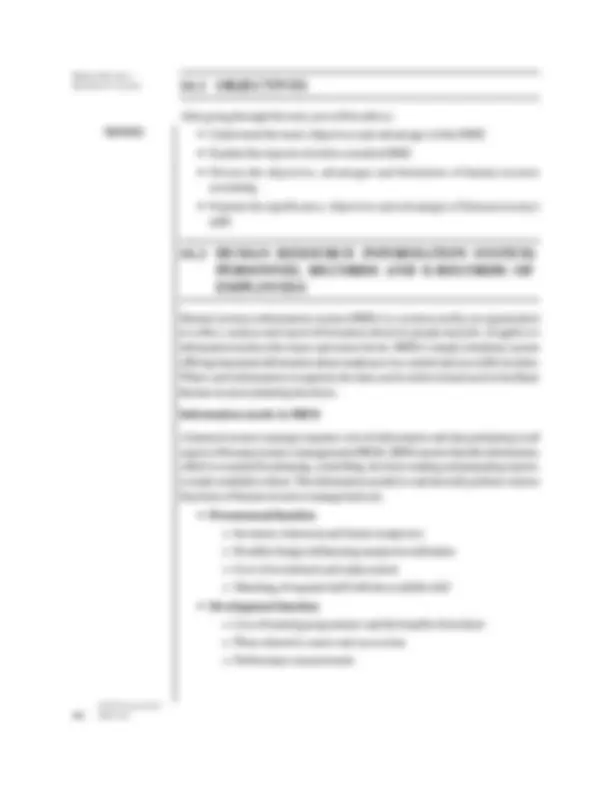



Study with the several resources on Docsity

Earn points by helping other students or get them with a premium plan


Prepare for your exams
Study with the several resources on Docsity

Earn points to download
Earn points by helping other students or get them with a premium plan
Community
Ask the community for help and clear up your study doubts
Discover the best universities in your country according to Docsity users
Free resources
Download our free guides on studying techniques, anxiety management strategies, and thesis advice from Docsity tutors
Human Resource Management (HRM) is a strategic and comprehensive approach to managing people within an organisation. It involves recruiting, hiring, training, evaluating, and rewarding employees to maximise their performance and align with the organisation’s goals. HRM also ensures compliance with labour laws, fosters a positive workplace culture, and supports employee development and well-being. By managing workforce planning, performance, compensation, and employee relations, HRM plays a vital role in organisational success. In today’s dynamic business environment, HRM is increasingly data-driven and aligned with long-term strategic planning, making it an essential function in both large corporations and small enterprises.
Typology: Lecture notes
1 / 2

This page cannot be seen from the preview
Don't miss anything!


Human Resource Information System
Self-Instructional Material 165
Structure
14.0 Introduction 14.1 Objectives 14.2 Human Resource Information System: Personnel Records and E-Records of Employees 14.2.1 Need, Objectives and Advantages of HRIS 14.3 Human Resource Accounting: Objectives, Scope and Importance 14.3.1 Objectives of HR Accounting 14.3.2 Advantages and Limitations of HR Accounting 14.3.3 Personnel Audit 14.3.4 Personnel Research 14.4 Answers to Check Your Progress Questions 14.5 Summary 14.6 Key Words 14.7 Self Assessment Questions and Exercises 14.8 Further Readings
This unit will discuss the Human Resource Information System or HRIS. HRIS can be defined as an integrated system used to gather, store and analyse information regarding an organization’s human resources (HR). This system helps automate and manage the organization’s HR, payroll, management and accounting activities. During recent times, organizations mostly use computerized HRIS. A computerized HRIS is an information system that makes use of computers to monitor, control and influence the movement of human beings from the time they indicate their intention to join an organization till the time they leave the organization.Accounting and auditing of human resources is also an integral part of the HRIS. Human resource accounting (HRA) is the measurement and reporting of the costs incurred for recruiting, hiring, training and developing employees and their present economic value to the organization. It involves the assessment of the costs and value of the people as organizational resources. Informed employers also voluntarily use HR audit as a tool for evaluation and control of personnel function. HR audit is used widely to check the organizational performance in the management of human resources. This unit will therefore discuss the importance of HRIS, with an emphasis on the needs, objectives and advantages of the system, and the significance of human resource accounting and audit.
Human Resource Information System
Self-Instructional 166 Material
After going through this unit, you will be able to: Understand the need, objectives and advantages of the HRIS Explain the steps involved in a modern HRIS Discuss the objectives, advantages and limitations of human resource accounting Explain the significance, objectives and advantages of human resource audit
Human resource information system (HRIS) is a system used by an organization to collect, analyse and report information about its people and jobs. It applies to information needs at the macro and micro levels. HRIS is simply a database system offering important information about employees in a central and accessible location. When such information is required, the data can be retrieved and used to facilitate human resource planning decisions. Information needs in HRM
A human resource manager requires a lot of information and data pertaining to all aspects of human resource management (HRM). HRIS ensures that this information, which is essential for planning, controlling, decision-making and preparing reports, is made available to them. The information needed to satisfactorily perform various functions of human resource management are: Procurement function o Inventory of present and future manpower o Possible changes influencing manpower utilization o Cost of recruitment and replacement o Matching of required skill with the available skill Development function o Cost of training programmes and the benefits from them o Plans related to career and succession o Performance measurement